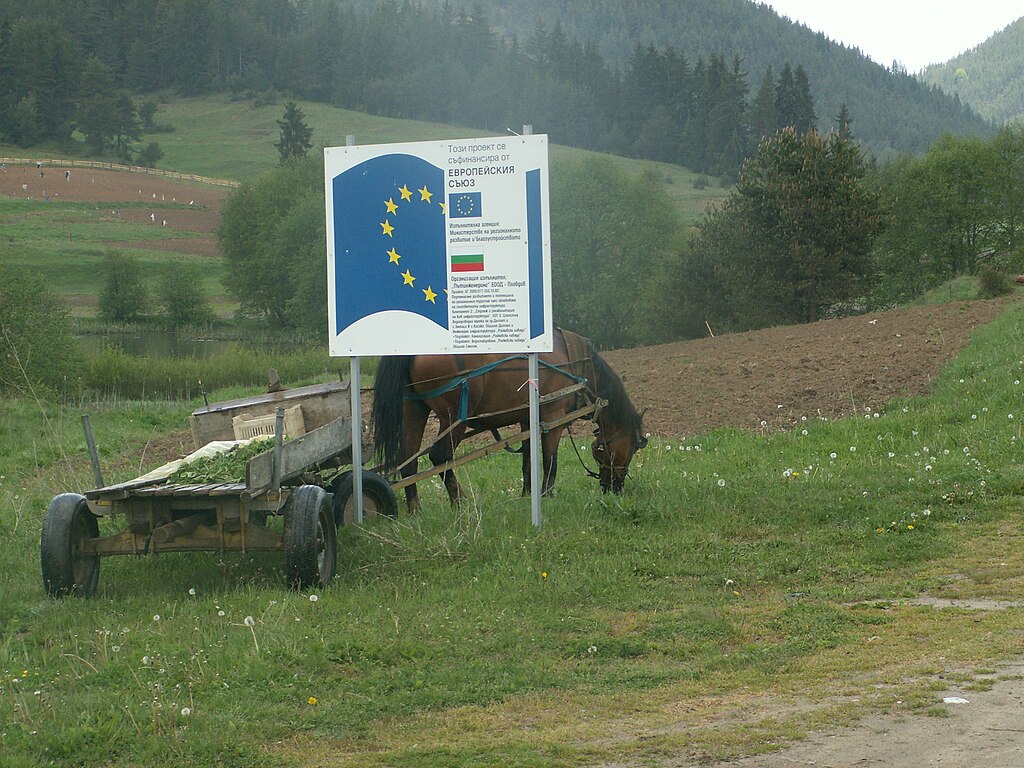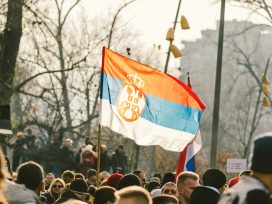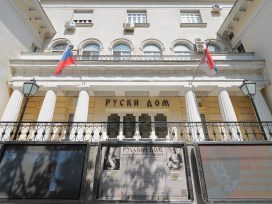EU enlargement: A new approach
Ukraine’s EU candidacy has brought new momentum to an EU enlargement process suffering from a major crisis of credibility. But reservations towards enlargement run deep. The EU should admit this and propose an interim goal that still offers candidate countries genuine incentive for reform.
In an ironic twist of history, Russia’s unprovoked war has brought Ukraine closer to European Union membership than ever before. Even enlargement-sceptical EU member states have had no choice but to declare their support for Ukraine’s accession ambitions. The French president Emmanuel Macron’s comment on 1 June that ‘we must remove the ambiguities and agree to have a Union which is enlarged, which is geopolitical’ was one significant example.
But the big question is how further enlargement can actually happen. Unlike NATO, the EU is not a club of like-minded countries content to co-ordinate and cooperate in one specific policy area. Member states give up parts of their sovereignty. They delegate considerable decision-making powers to the EU and accept the European Court of Justice as the highest arbiter. They belong to the European Single Market, a vast area where goods, services, people and capital can travel across national borders unhindered. This is made possible by almost 100,000 pages of EU legislation, binding on all member states.
The EU has very few of its own institutions. For the implementation of its rules and policies, it depends on the institutions of its member states. These must be reliable and capable of working in accordance with the vast body of the acquis. Otherwise the EU’s functioning is threatened.
Following a ‘geopolitical approach’ cannot therefore mean admiting Ukraine into the EU without it having met the demanding membership criteria. But it can – and should – mean that the EU makes a serious offer to Ukraine (and other European democracies hoping to enter) to participate in a credible accession process. This is more exciting than it sounds.
It is the process leading to accession rather than actual membership that changes countries more substantially. In terms of transforming states on a broad scale, the accession process is the most successful tool ever developed. Every single former communist country admitted to the EU is proof of its transformative power. There are differences in how new members have subsequently developed, but there is not a single case for which it would be fair to say that the process failed.
But ever since the central eastern European countries joined the EU in 2004 and 2007, the process has been neglected. Stability in Europe’s periphery has been taken for granted and, against the backdrop of multiple crises, further enlargement pushed into the distant future. EU members have remained silent when their peers blocked accession countries through vetoes that had nothing to do with the criteria. With no credible accession prospect, the process stopped delivering reforms. This reinforced the belief among sceptics that the countries in the queue were unfit for membership.
Many now attest to a ‘new momentum’, but the underlying reservations that have formed in the last decade, many of which are legitimate, are not likely to go away anytime soon. The challenge is to find a way to make the accession process work under the current circumstances.
Success or failure in this will not only determine whether Ukraine and other membership contenders – such as Moldova, Georgia and the Western Balkan countries – follow their eastern European peers to become stable and increasingly prosperous democracies. It might also very well decide the shape of Europe’s future as a whole.

Photo by Hubertgui, Public domain, via Wikimedia Commons
Transformative power
It is a familiar south-east European story: a botched transition from communist rule, empowering networks of the ancien regime and a few new oligarchs. Corruption rules; the economy is in tatters. The poverty rate stands at 36 percent, up from 20 percent four years earlier. Gross Domestic Product per capita based on purchasing power reaches barely a quarter of the EU average. Upcoming elections offer a choice between old strongmen, new nationalists and a bunch of quarrelling reformist parties, all polling below 10 percent.
This was Romania in 2000. In the second round of the presidential elections in December, Romanians could choose between Ion Iliescu, a former member of the central committee of the Communist Party, and Corneliu Vadim Tudor, an antisemitic poet and journalist turned racist politician. Iliescu, who had already been president from 1989 to 1996, won with two-thirds of the vote. In the parliamentary elections, his Social Democratic Party won 37 percent. Tudor’s Greater Romania Party won 20 percent. All the other competitors remained in single digits.
The eventual outcome was a government led by Iliescu’s party colleague, Adrian Nastase. Expectations were low. ‘The immediate problem is to cope with the winter,’ explained the Economist. ‘After years of misery, Romania’s economy is expected to grow this year by a mere 2%. Inflation is nudging 40%, the average wage is only $100 a month. Millions of Romanians cannot afford to heat their homes properly. Mr Nastase cannot easily find the money to subsidise heating costs.’
But then the tide turned. The poverty rate started to decline, reaching 25 percent in 2003.1 Net Foreign Direct Investment, which had lingered below 3 percent of GDP for years, started to pick up, surpassing 9 percent in 2006. And this was only the beginning. Looking at purchasing power-adjusted GDP per capita, Romania went from 26 percent of the EU average in 2000 (behind all current EU member states and even North Macedonia and Serbia) to 77 percent in 2022, at the same level as Hungary and Portugal, and overtaking five other EU member states (Latvia, Croatia, Greece, Slovakia and Bulgaria).
Romania’s citizens are still poorer than those of wealthy EU member states; its politicians are more corrupt than those of Denmark; its democratic institutions are more fragile than those of the Netherlands. But no one can deny that Romania’s transformation from Europe’s poorhouse into a dynamic economy based on a robust political system has been a success story. (Along the way Romania has also delivered some of Europe’s highest-level convictions for corruption, including of Nastase himself.)
How did this happen? There were many factors of course. But one can hardly be overestimated: from 2000 to 2006, Romania underwent the EU accession process that allowed it to join as a full member in 2007. As the political scientist Alina Mungiu-Pippidi put it in 2006, ‘The existence of a European option prevented Romania from staying as Albania or regressing to become a new Belarus.’2
What does the accession process mean?
The accession process is essentially about three things.
First, a credible promise that every candidate country can reach the goal (EU membership) through its own efforts. When, in December 1997, the EU invited six countries to open negotiations, it made sure that the five other eastern European hopefuls were kept as tied to the process as possible, stressing that ‘the preparation of negotiations with Romania, Slovakia, Latvia, Lithuania and Bulgaria will be speeded up’. Slovaks clearly believed that this promise was real. In 1998, seeing their neighbours pull ahead while their country remained stuck under Vladimir Meciar, they voted him out of office, paving the way for a dramatic catch-up process.
Second, accession is about the actual process. What are euphemistically called ‘negotiations’ means bringing the legal framework of the country into line with EU legislation in all areas relevant for the functioning of the EU, from environmental protection and product safety standards to public procurement and state aid. The process also means establishing new institutions or adapting existing ones in order to implement all these EU policies, laws and regulations. This might sound modest, but it is not. EU policies touch upon most areas. As Silvana Lyubenova, a civil servant involved in Bulgaria’s accession negotiations, put it, ‘Accession negotiations mean making a time schedule for your reforms.’3
Third, the accession process entails substantial financial assistance and tailored support programs. In Romania’s case this amounted to € 5.7 billion between 2000 and 2006.4 Unlike classical development assistance, these multi-billion euro funds are designed to help candidate countries implement EU-compatible legislation, set up and reform institutions, and develop the skills to apply for complex multi-million-euro infrastructure projects according to EU rules and procedures. After becoming members, this allows them to access even more support to help their economies catch up.
For Romania, all this took years, but in comparison with the ongoing accession processes, not that many: the country applied in 1995, started negotiations in 2000, closed them in 2004 and became a full EU member on 1 January 2007. The core of the process, the negotiations, lasted four years and 10 months.
A process in ruins
The key reason why the process was so successful was its meritocratic nature. Countries that were doing well on reforms progressed, those that weren’t fell behind.
Some member states were tempted to use the accession process to push for concessions on specific bilateral interests: Austria with regard to nuclear power plants in Slovakia, Italy with regard to property in Slovenia expropriated during communism, Germany with regard to the Beneš decrees and the rights of Sudeten-Germans expelled from Czech lands after the Second World War. Eventually, however, all these issues could be overcome without threatening the integrity and credibility of the process itself.
When Slovenia blocked Croatia over a dispute primarily over the sea border between the two countries in late 2008, an immediate reaction followed. Enlargement commissioner Olli Rehn engaged in intensive shuttle diplomacy. Eventually, after the resignation of Croatia’s prime minister, a solution drawing heavily on one of Rehn’s proposals was fleshed out by Slovenian and Croatian negotiators, assisted by the Swedish EU presidency. Although negotiations were formally put on hold for 11 months, all technical meetings continued. Croatia effectively lost only little time.
Since then, however, bilateral vetoes have proliferated. When the European Commission recommended the start of accession negotiations with North Macedonia in 2009, Greece objected on the grounds that the name of the country implied claims to Greek territory. The impasse lasted for nearly a decade. In 2019, North Macedonian leaders finally agreed to rename their country ‘North Macedonia’, only to find their country blocked by France.
Macron told reporters that, ‘We need a reformed European Union and a reformed enlargement process, a real credibility and a strategic vision of who we are and our role.’ After France gave up its objections in 2020, Bulgaria blocked the opening of accession talks because of objections related to North Macedonian history writing and teaching. Pending constitutional changes to alleviate Bulgaria’s concerns, it remains unclear if North Macedonia will be allowed to finally start substantive negotiations later this year.
North Macedonia is not the only country forced to clear arbitrary hurdles. Bosnia and Herzegovina was asked to meet 13 conditions before the EU would accept a membership application – something the EU had never demanded from any other country.
Kosovo, not being recognized by five EU member states, currently has no membership prospects at all. While the Commission insists that ‘Kosovo has a clear European perspective as part of the wider Western Balkans region,’ when it finally handed in its membership application in December 2022, Spain made immediately clear that it ‘does not recognize the independence of Kosovo and will therefore vote against any procedural decision and granting of candidate status.’
Taken together, this has all hugely damaged the credibility of the accession process.
Making things worse, it has become unclear how progress is measured. The process is structured in 33 ‘chapters’ or policy areas. In the negotiations these chapters are opened and – once the country is deemed ready in that area – closed. The European Commission assesses annually how accession countries are progressing and allocates each chapter one of five grades (early stage; some level of preparation; moderately prepared; good level of preparation; well advanced).
In the previous enlargement rounds, the number of opened and closed chapters gave a reliable indication of how far a country had advanced. But this is no longer the case. Whether a chapter has been opened or not says nothing about the country’s preparedness in that area. Serbia, for example, was allowed to open four chapters with the low grade of ‘some level of preparation’, while 11 chapters with a better grade of ‘moderately prepared’ have not been opened yet.
According to the latest assessments by the European Commission, North Macedonia is as prepared as Serbia and nearly as prepared as Montenegro. In the time that Serbia and Montenegro have been negotiating, North Macedonia has not been allowed to open a single chapter. What has been the point of nine years of accession talks with Serbia and eleven years with Montenegro if a country that has not yet opened negotiations is as prepared for accession as they are?
In the last three years, Bosnia, North Macedonia and Serbia have barely moved closer to meeting membership standards. At the current level of improvement, it would take Serbia another 99 years to reach an average score of a ‘good level of preparation’. Albania has made most progress. But even then, it would take Albania another 28 years to reach an average grade of a ‘good level of preparation.’
Another indicator of the problems of the current process involves the closing of chapters. Currently five countries are formally negotiating: Albania and North Macedonia (since 2022), Serbia (since 2014), Montenegro (since 2012) and Turkey (since 2005).5 All need to close 33 chapters, meaning 165 chapters in total. However, so far they have closed only six chapters all together. The last country to close a negotiation chapter was Montenegro in June 2017.
Not a single negotiation chapter has been closed by any country for more than six years! This is longer than it took each and every of the 13 countries that joined in 2004, 2007 and 2013 to open and close all their chapters!
All of this means that incentives to reform have vanished. Why invest political capital and credibility if there is a considerable risk of being left out in the cold, making you look silly and naive in front of your electorate?
New momentum?
The enlargement discourse started to shift in 2022 after Russia’s invasion of Ukraine and Ukraine’s membership application. But a closer reading suggests continued hesitation.
After the European Council on 23 June 2022, when Ukraine and Moldova were declared candidates for membership, Macron admitted there was a ‘need to advance’. He explained that ‘this is a question of credibility but also a geopolitical issue of stabilizing the Western Balkans.’ But then he added that, ‘at a certain point we see that there is a tension between this geopolitical approach and our ambition that we have to deepen our Europe.’
How can that tension be resolved? Through time, Macron suggested: ‘We have the enlargement process. Very good … but let’s be clear: it will take a lot of time. Maybe some will not be able to finish it. But we have to think much more quickly and stabilize our neighbourhood. And somehow – we have to be honest – we don’t have to live in the same house all together but we can live on the same street.’
Olaf Scholz said at the end of August 2022 in Prague that he was ‘committed to the enlargement of the European Union … But we must also make the EU itself fit for this great enlargement. This will take time, and that is why we must start now.’
The Council conclusions from December 2022 state that the accession process will be made ‘more focused on fundamental reforms, more predictable and based on objective criteria and rigorous positive and negative conditionality.’ The Council also looked forward to ‘phasing-in’ individual EU policies, the EU market and EU programmes’ and encouraged ‘the further advancement of gradual integration between the European Union and partners already during the enlargement process in a reversible and merit-based manner.’
Suddenly, the topic was being taken more seriously. In a joint op-ed in the Frankfurter Allgemeine Zeitung in January 2023, Scholz and Macron wrote that, ‘we are striving for rapid and concrete progress in the EU enlargement process. At the same time, we must ensure that an enlarged European Union remains capable of acting, with more efficient institutions and faster decision-making processes, particularly through the expansion of qualified majority voting in the Council.’ On 9 May 2023, Scholz tweeted that ‘progress made towards accession must be rewarded. We have said to the Western Balkan countries, to Ukraine, Moldova, and more distantly to Georgia: you belong with us.’
At a conference in Bratislava on 31 May this year, Macron stated that ‘the question is not whether we should enlarge – we answered that question a year ago – nor when we should enlarge – for me, as swiftly as possible – but rather how we should do it.’ He added that ‘our current method is not working.’
According to Macron, the EU needed to avoid two mistakes: First, ‘to give hope to the Western Balkans, Ukraine and Moldova, and then procrastinate.’ He went on to say that, ‘we are very familiar with this tactic, we’ve been using it for a long time.’ Second, ‘to say “let’s enlarge, it’s our duty and in our geopolitical interest … Let’s do it. We’ll reform later.” This would also be disastrous.’
But despite all this, the key problem persists. Enlargement-sceptical EU members, including France, might have come around to the necessity for further enlargement, but they cannot see how this can work without reforming EU decision-making procedures first.
This means that membership cannot be obtained on merit. Rather, it depends on the current EU members and their ability to find agreement on internal EU reform. When this will happen nobody knows, as it requires support from all members, some of which have very different positions on the issue.
There is a high risk that the eventual outcome of the ‘new momentum’ will be to formally open accession negotiations with Ukraine and Moldova, but without any substantial changes in the process as such. This would leave both countries, together with all other accession candidates, in a process that is leading nowhere. More than one-and-a-half years after the membership applications of Ukraine and Moldova, it remains unclear how to move on.
So far only the words in the enlargement discourse have shifted. The deeds have not.
A simple proposal
Any successful revival of the accession process, restoring its credibility and transformative power, needs to do four things:
– provide an attractive goal that is attainable on merit;
– provide rewards on progress using objective criteria;
– make bilateral vetoes as infrequent as possible;
–take the concerns of sceptical EU member states into account.
This might sound contradictory, but there is a simple way to square the circle. The EU should admit the obvious: it cannot promise that when an accession country has met all criteria, the EU will be ready to take it in. Instead, the EU should propose a different, attractive goal that accession countries can reach through their own efforts.
The EU and its member states should declare that if a country meets all the membership criteria, including respect for the rule of law and human rights, it will be immediately admitted to the Single Market and get access to the four freedoms and EU funds.
This is an ambitious goal that would bring a country very close to full membership. The Single Market and the four freedoms (free movement of goods, services, persons and capital) cover most of the EU’s legislation and most EU policies. Joining the Single Market would also require countries to fulfill the Copenhagen criteria, including the rule of law, which is required for the smooth functioning of the Single Market.
In practice, the citizens and businesses of the countries that manage to join the Single Market would enjoy almost the same rights and benefits as those granted to citizens and businesses of EU member states. However, their political representatives would not (yet) get a seat at the decision-makers’ table in Brussels.
Full EU membership would remain the goal. But participation in the internal market would be a big step on the way to full membership – an attractive, achievable, interim goal. This has already worked in the past: Austria, Finland and Sweden were offered membership in the internal market in the first half of the 1990s, because at that time some member states were hostile to enlargement. Once political conditions within the EU changed, they were well prepared and able to join the EU within a short time frame.
This approach offers several major advantages.
First, Single Market membership is a highly attractive goal. It is true that being in the Single Market but not in the EU makes a country a rule taker, but not a rule maker. This is the position of Norway. When the EU changes the rules, it is forced to accept them. But Norway clearly thinks this is worth it, since it pays to be part of the Single Market (€2.8 billion between 2014 and 2021). Moreover, even countries that are not in the Single Market must accept many of its rules if they want to engage economically more closely. All this is much easier if it is seen as a step on the way to full membership.
Second, progress can be measured objectively. The European Commission does this already through its annual reports. The benchmark for Single Market membership could be put at a ‘good level of preparation’ for all chapters.
Third, this approach removes bilateral blockades for the largest part of the process. A unanimous decision by all the member states to admit the country to the single market is required only at the very end. The process once again becomes truly meritocratic, with progress depending on the countries’ own efforts.
Fourth, no institutional changes are required at the EU level: all this can be done with the tools the Commission already has available. There is no need for any new instruments. Legislative changes are needed only to regulate the accession of successful countries to the Single Market and access to EU funds.
Fifth, this proposed solution addresses the concerns of France and all other member states that think that internal EU reforms need to be carried out before admitting new EU members.
Sixth, this approach can be offered to all European democracies, regardless of their formal status in the accession process. While the prospects for starting membership negotiations still appear distant in the cases of Kosovo, Bosnia and Herzegovina and Georgia, they would strongly benefit from a credible and tangible vision for a better future.
Finally, this approach would counteract risk that the determination of Ukraine and Moldova will dissipate once they formally start negotiations.
A remaining challenge is financing (also the most contentious issue before the ‘big bang enlargement’ of 2004). A poor EU member receives much more money than a poor country in the accession process. What happens if an accession country joins the Single Market? There is no predefined answer. It has to be negotiated. Norway, as a very rich country, pays to be in the Single Market. Balkan countries, much poorer, should receive funds. With a combined economy half the size of Romania, the Western Balkans and Moldova could be treated like full members without incurring high costs.
This is different for Ukraine. Providing EU funds for this large and poor country would have a major impact on the EU budget. How much can the EU afford? How much is it willing to pay? Would agricultural funds be included? Resolving these questions will be a serious challenge. But they must be resolved anyway, should Ukraine ever join the EU.
The bottom line is that, for it to work, the process leading to Single Market membership and the four freedoms must be preferable to the status quo for both accession countries and EU member states. Once this is realised, we can really start talking about a new momentum for enlargement.
A version of this article first appeared in IWM Europe’s Futures.
Alan Smith, ‘The Romanian Economy since 1989’, in: David Phinnemore (ed), The EU & Romania. Accession and Beyond, Federal Trust for Education and Research, 2006, pp. 29-37, p. 36.
Alina Mungiu-Pippidi, ‘Europeanisation without Decommunization: a case of elite conversion’, in: David Phinnemore (ed), The EU & Romania. Accession and Beyond, Federal Trust for Education and Research, 2006, pp. 17-28, p. 28.
Interview with Silvana Lyubenova, Sofia, 29 June 2007.
Sources: General Report on pre-accession assistance (Phare – ISPA – SAPARD), years 2000, 2001, 2002, 2003, 2004, 2005, 2006. The 2005 report only gives figures for Romania and Bulgaria together. As an estimate we allocated 66% of this total to Romania (in the previous year, 2004, Romania’s share was 65% and in the following year, 2006, it was 67%).
Three are candidate countries: Bosnia and Herzegovina, Ukraine and Moldova (since 2022). Two are potential candidates: Georgia and Kosovo.
Published 4 October 2023
Original in English
First published by Eurozine / IWM Europe’s Futures
© Kristof Bender / IWM Europe’s Futures / Eurozine
PDF/PRINTIn collaboration with
Newsletter
Subscribe to know what’s worth thinking about.
Related Articles

Talk of demilitarization and mobilization divides opinion. Could giving women and other feminized groups more agency in wartime decision-making flip their traditionally passive role, providing relief from trauma and injustice?

From Bosnia to Afghanistan, the neoliberal peace-building model has compounded conflicts and inequalities by eroding the core function of states. But in Ukraine, the co-optation of the recovery process by private economic interests is being taken to a whole new level.





